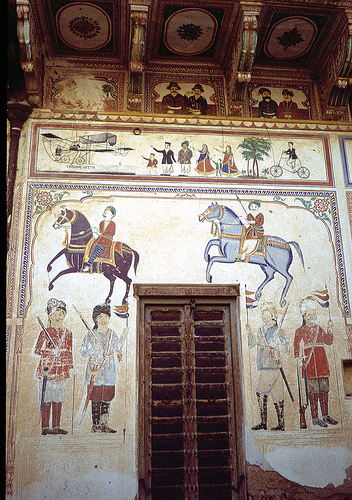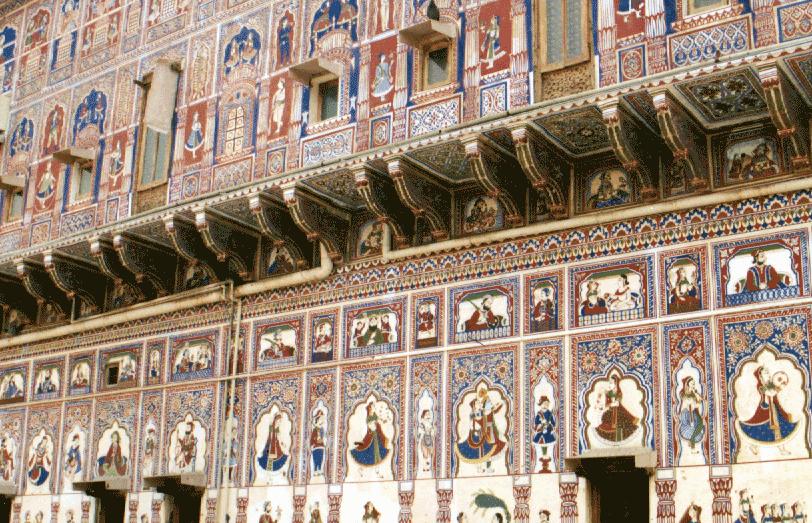
Painting on A Room's Gate inside Haveli
Northern Rajasthan is extremely rich in artwork especially in smaller towns. Contrary to typical expectation of a tourist, smaller towns in this area of Shekhawati are rich in art. Northern Rajasthan has fabulous buildings which were erected by rich merchants, who often traveled on routes from Gujarati Ports. If you are visiting or planning to visit this part of Rajasthan, look out for Havellis, Baoris (step-wells), Chhatris (cenotaphs) and Mosques. Few places that one must visit are,
- Parsurampura
- Ramgarh
- Mukundgarh
- Nawalgarh
- Jhunjhunu
- Mahansar
- Fatehpur
In each of these places you will see colored Havellis, typical rural culture and architecture of early days. Havelli of Ram Gopal Poddar in Ramgarh will enthrall you with magnificent paintings. Fort of Rajah Mukund Singh in Mukundgarh is worthy of a visit. It is spread over 2 acres and represents a testimony to glory of kings. This fort is nearly 300 years old and has been converted to Hotel where one can stay. Handicrafts market is a great stop for shopping. Kanoria Havelli in Mukundgarh is very interesting. One can entertain oneself with Puppet Shows or by sitting at pool side.
Nawalgarh has one of the fines frescos in whole region. In Nawalgarh, you can visit the Eco farm as well. Ramesh Janid runs a travel agency and the resort. All means of alternate energy generation are used here. One can eat vegetarian meal, hire a vehicle and roam further with a guide. Few places you should not miss in Nawalgarh are:
- Aath (eight) haveli complex,
- Anandilal Poddar haveli,
- Jodhraj Patodia haveli,
- Bansidhar Bhagat haveli,
- Chokhani haveli,
- Hotel Roop Niwas Palace
Jhunjhunu resembles smaller towns in North India. However, some exceptions that will interest you are Rani Sati Mandir (one of its kind in whole world). It commemorates the death of a Marwari widow by Sati, usually performed by Rajput women.

A WallPainting from Haveli in Fatehpur
In particular, if you visit the Sone Ki Dukan Havellis, you will see paintings done in gold, real gold in Mahansar. You can see stories from Ramayana, incarnations of Vishnu in the paintings.
The gold makes these look as good as new. Some of these Havellis have been restored to their original glory like one in Fatehpur. Devra, Singhania and the Goenka havelis make this place extremely worthwhile on your travel map. Built in 1920, you can see Jalan Havelli as well. This Havellis has beautiful Japanese tiles amongst other things. In the Goenka Havelli look out for a painting of Lord Krishna who is shown with different women looking like an elephant. Parsurampura is again famous for its fresco paintings.
For more information interested tourists might refer to ‘Shekhawati, Rajasthan’s Painted Homes’ by Pankaj Rakesh and Karoki Lewis (Lustre Press, New Delhi and The Netherlands).

Leave a Reply